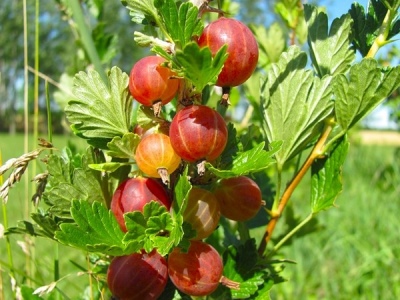
- Authors: All-Russian Institute of Selection and Technology of Horticulture and Nursery
- Appeared when crossing: Neslukhovsky x Kolobok
- Name synonyms: Ribes uva-crispa Laskowiy
- Growth type: medium-sized
- Description of the bush: compact
- Escapes: long
- Thorniness: weak
- Thorns: single, short
- Sheet: bright green
- Berry size: average and above average
The gooseberry is an old inhabitant of the gardens of Russia, widely known back in the days when the country was called Rus, and the shrub of the bersen-bersen, the bear's paw. Unpretentious and tenacious, useful and versatile, it attracts the attention of gardeners today. There are more than 1500 thousand varieties in the world. The berry of the Laskoviy gooseberry variety (synonym for Ribes uva-crispa Laskoviy) is intended for fresh consumption, juices, jams, jam, preserves are brewed from it, and wine is made.
Breeding history
The authorship in the breeding of the variety belongs to the breeders of the All-Russian Institute of Selection and Technology of Horticulture and Nursery. Neslukhovsky and Kolobok were used as parents.
Description of the variety
Medium-sized compact bushes with weak thorniness emit long shoots, and have a strong shoot-regenerating ability. The branches are covered with bright green leaves. The thorns are short, single, the transportability is average - from 19 to 25 days, the marketability is high.
Benefits of Laskovoy:
compactness;
low consistency;
strong immunity;
rich chemical composition;
medicinal properties of berries and leaves.
The disadvantage is the increased acidity, which prevents the use of this variety for people with gastrointestinal problems. Conditional disadvantages are the demands on protection from drafts and northern winds, the level of moisture in the soil.
Characteristics of berries
Rounded-oval medium-sized and larger berries weighing 4-5, and with good agricultural technology, up to 7 grams, are colored bright red with a noticeable bloom of prune.
Taste qualities
The abundant juicy pulp has a sweet and sour taste and a pleasant gooseberry aroma. The assessment of the tasting committee is 4.53-4.67 points out of 5 possible.
Ripening and fruiting
Affectionate belongs to the mid-early category - the crop is harvested in early August.
Yield
The variety is characterized as high-yielding - on average, up to 7 kilograms of healthy and tasty berries are harvested from a bush.
Growing regions
Affectionate gooseberry is able to grow and bear fruit throughout the territory of the Russian Federation, however, it fully reveals its potential in the middle zone and the Non-Black Earth Region.
Landing
For planting, choose sunny or slightly shaded areas, with protection from cold northwestern winds and drafts. The variety does not tolerate swampy lowland areas and the proximity of groundwater, which is also paid attention to when choosing a site. The soil should be fertile, loose and breathable, with a neutral acidity level. The optimal planting time is spring or autumn, however, preference is given to the autumn season, about 1.5 months before the onset of cold weather. If the seedlings are planted in the spring, then they do it before bud break. The most viable plants of two or three years have a well-developed root system with 20 cm roots. Such a plant is capable of giving up to 5 full-fledged shoots in the first season, and the next year to please with the first berries.
The dimensions of the planting pit are 50x50x50 cm. The removed soil is cleaned of weed roots, enriched with organic matter, superphosphate, potassium salt, wood ash. Peat and river sand are added to heavy clay soil. If the soil has an elevated pH level, then dolomite flour, chalk and even wood ash help to normalize the acid-base balance.During planting, each layer of the covered earth is compacted and watered with warm water.

Growing and care
Further care for Laskov consists in weeding, loosening, timely watering, sanitary and shaping pruning. Watering is carried out 3-5 times per season for adult bushes, and once every 2 weeks in the first year after planting. If rainy weather is established, additional irrigation is not required. The first watering is carried out during flowering and budding, the second during berry filling. The abundant autumn watering will help the gooseberries to safely endure the winter and frosts.
Top dressing starts from the third year, if the planting pit has been properly filled. In the spring, the plant needs nitrogen fertilizers to build up its vegetative mass. During the period of berry tying, gooseberries are fed with potassium-phosphorus preparations. Autumn is the time for the introduction of organic matter, the trunks are covered with a thick layer of humus or compost.



Disease and pest resistance
Affectionate gooseberry variety has a fairly strong immunity so as not to cause gardeners' claims. It shows good resistance to fungal diseases, powdery mildew and anthracnose. This is not to say that he is not at all afraid of pests, such as gooseberry shoot aphids, moths, sawflies, therefore preventive treatments with insecticides and fungicides will help to secure planting and save the quality and quantity of the crop.

In order for the gooseberry to produce a good harvest, it is necessary to devote time to disease prevention.
Resistance to adverse climatic conditions
The variety is highly resistant to drought and frost, which made it possible to grow it in all regions, from the southern regions to the Irkutsk region.




































































